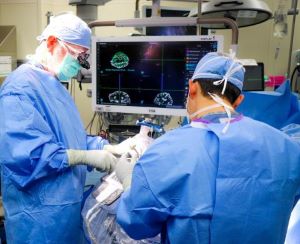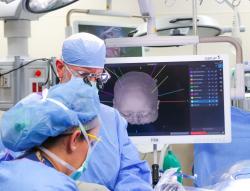
A pediatric epilepsy diagnosis can be devastating. Few parents really understand the condition, though they’re all-too familiar with the terror and helplessness they feel when their son or daughter experiences a seizure.
Many are surprised to learn that epilepsy is the most common of all neurological disorders. One in 26 people suffers from the condition – including more than 470,000 children in the U.S. alone – yet few people know much of anything about the disease.
At Barrow Neurological Institute at Phoenix Children's Hospital, our goal is to provide hope and healing to kids with epilepsy. As a Level 4 Epilepsy Center, the highest designation available from the National Association of Epilepsy Centers, we treat some of the very toughest cases using the most advanced medicine available.
Today’s treatments deliver excellent outcomes – even for children who don’t respond to traditional anti-seizure medications. For many patients, a surgical intervention is the best approach:
Laser Ablation: A Cure for Epilepsy
For children with focal epilepsy – meaning the seizures originate from a specific, confined area of the brain – laser ablation surgery may be the best option. Using this cutting-edge procedure, pioneered by Angus Wilfong, MD, associate director of Barrow at Phoenix Children's and chief of Pediatric Neurology, we are curing children with some forms of epilepsy including hypothalamic hamartoma (HH).

In laser ablation surgery, we use laser light to heat and eradicate lesions. With high-resolution monitors, we can see exactly where and how much heat is being applied, allowing us to pinpoint the treatment with incredible accuracy. The surgery is minimally invasive, requiring just a single stitch, and recovery is quick and simple.
As the only center in the world with the capacity to provide resting-state MRI to isolate a lesion, we have unmatched precision in identifying the affected area to treat. Laser ablation procedures are now aided by the Medtronic Stealth AutoGuide robotic guidance system, which has improved surgical precision to within sub-millimeter accuracy.
The effectiveness of the procedure, combined with our careful decision making with epilepsy patients, has resulted in 100% success; every one of our laser ablation patients is now cured of epilepsy.
Neuromodulation: An Option for Intractable Epilepsy
Of course, surgery isn’t an option for all patients, and many children don’t respond adequately to medication. In these cases, technologic advances like neuromodulation or ketogenic diet are dramatically improved outcomes.

- Vagus Nerve Stimulation (VNS) is designed to prevent seizures by sending regular, mild pulses of electrical energy to the brain via the vagus nerve, which passes through the neck as it travels between the abdomen, chest and the lower part of the brain. The pulses are generated by a pacemaker-like device that is placed under the skin on the left chest wall. Neurologists can adjust the strength and timing of the pulses to personalize treatments for individual patients.

- With Responsive Neurostimulation (RNS), electrodes are surgically implanted in the area of seizure focus and are then connected to a device implanted in the skull under the scalp. Electrical leads from the device constantly monitor brainwaves, looking for brain activity that may lead to a seizure. The RNS sends pulses that instantly disrupt impending seizures and normalize brainwaves, often before the patient feels any symptoms. This device comes with a simple remote monitor that collects brainwave data and seizure activity, giving us a better understanding of patients’ seizures.
VNS and RNS work 24 hours a day, and the outcomes are simply astounding. In addition to reducing or eliminating seizures, patients don’t suffer any of the side effects associated with anti-seizure medication. They’re truly breakthrough treatments for patients with uncontrolled epilepsy.
Ending stigmas and creating cures
Our ability to diagnose and treat epilepsy has improved dramatically in recent decades. New technologies allow us to see the brain at an incredible level of detail and understand why our patients are experiencing seizures.
Of course, our primary goal is to stop the seizures. The specifics of the treatment are a secondary concern. At Phoenix Children’s, we are working to design the best and most appropriate treatments, whether through surgery, neuromodulation, diet or medication. Ultimately, our goal is to improve our patients’ quality of life – and to provide hope where there was none before.
